Choosing the Right MIG Torch for Your Needs
March 31, 2021
If you’re going to start MIG welding, you’ll need two things: a welding machine and a welding torch. Every UNIMIG welder comes with a base torch, but plenty of applications might require that you switch up the type of torch you connect to your machine. No matter what you might need, we have it.
Binzel vs Bernard vs Tweco
What’s the difference? The main difference between the three is the original manufacturers of each. Tweco was born out of a basement in 1936, Binzel popped up in 1945, and Bernard joined the scene in the 1950s. Since then, they’ve dominated the welding industry with their three styles of MIG torches.
The other difference is their consumables. Despite the fact that these three guns look almost identical, the consumables inside them are not interchangeable.
Every UNIMIG MIG welder comes with a Binzel style torch, so you’d need to buy Binzel style consumables. They’re all basically the same thing, but slight differences in the gun models mean that a Binzel consumable won’t fit into a Tweco gun and vice versa.
Air vs Water-Cooled
This one is pretty self-explanatory. Air-cooled torches are cooled by air (with a fan inside the machine), and water-cooled welders are hooked up to a water-cooler unit. Water-cooled torches have a higher duty cycle and so will last longer before heating up.
Duty Cycle
Duty cycle is measured in 10-minute increments, so if you have a 60% duty cycle, you’ll have 6 minutes of constant use and then 4 minutes cooldown time. Welding torches have their own duty cycles that are separate from the machines.
Torch duty cycles are much higher than a machine’s, though, so you’ll pretty much never have to worry about your torch overheating before your machine. The only way you’d manage something like that is if you were to attach, say, an SB15 torch (max 180A) onto a Razor 500 Welder set to its max 500 amps.
If a torch does overheat, it won’t shut off like the machines do; the consumables inside it will just start burning up, as there’s no thermal overload protection on them.
The other difference between the duty cycle listed on a UNIMIG machine and a UNIMIG torch is that the machine’s duty cycle is its performance at the maximum amps.
In contrast, a torch can run on higher amps than what is listed. The listed duty cycles on the torches are the recommended max amps they should be used at (and are roughly 75% of the max power of the machines they’re paired with), but they can all run at higher amps.
This does affect the duty cycle, which will get lower the more you up the amps. Even with a lowered duty cycle, a torch will still last longer than the machine.
There’s a good reason for the way every machine is paired up with its torch, and the torch provided will always be able to handle whatever the machine is pumping out. You don’t have to stress about whether the torch is the right match for your welder.
Binzel Style MIG Torches
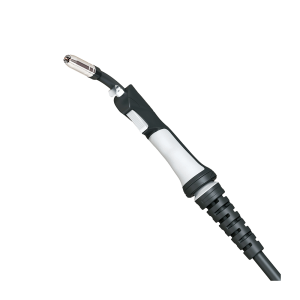
SB15 BINZEL Style MIG Torch
- Air-cooled
- Wire size 0.6mm-1.0mm
- CO2 duty cycle: 60% @ 180A
- Mixed Gas duty cycle: 60% @ 150A
View more info: SB15 BINZEL Style MIG Torch
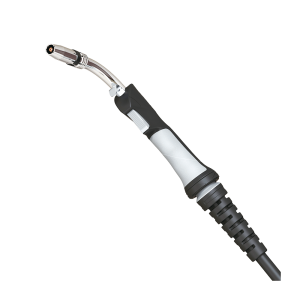
SB24 BINZEL Style MIG Torch
- Air-cooled
- Wire size 0.6mm-1.2mm
- CO2 duty cycle: 60% @ 250A
- Mixed Gas duty cycle: 60% @ 220A
View more info: SB24 BINZEL Style MIG Torch
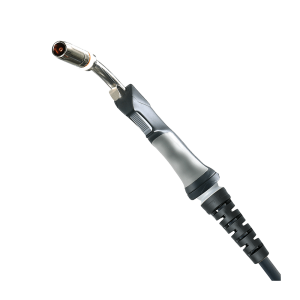
SB25 BINZEL Style MIG Torch
- Air-cooled
- Wire size 0.6m-1.2mm
- CO2 duty cycle: 60% @ 230A
- Mixed Gas duty cycle: 60% @ 200A
View more info: SB25 BINZEL Style MIG Torch
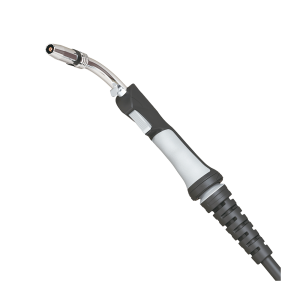
SB36 BINZEL Style MIG Torch
- Air-cooled
- Wire size 0.8mm-1.2mm
- CO2 duty cycle: 60% @ 300A
- Mixed Gas duty cycle: 60% @ 270A
View more info: SB36 BINZEL Style MIG Torch
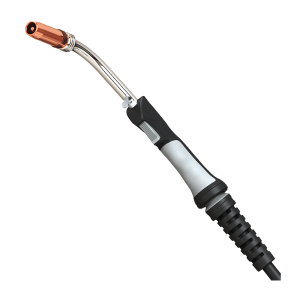
SB38 BINZEL Style MIG Torch
- Air-cooled
- Wire size 1.0mm-1.6mm
- CO2 duty cycle: 60% @ 340A
- Mixed Gas duty cycle: 60% @ 300A
View more info: SB38 BINZEL Style MIG Torch
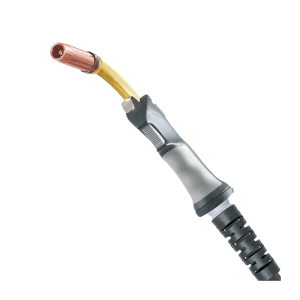
SB500 Water-Cooled BINZEL Style MIG Torch
- Water-cooled
- Wire size 1.0mm-1.6mm
- CO2 duty cycle: 100% @ 500A
- Mixed Gas duty cycle: 100% @ 450A
View more info: SB500 Water-Cooled BINZEL Style MIG Torch
Our MIG welders come packaged with torches that are capable of handling the max amps they’re putting out, so if you’re buying your first welder, you won’t need to stress too much about which torch is going to be the best for you. We’ve already done the work for you and selected a torch that will suit the machine, and therefore should suit your needs as well.
However, if you are looking to swap torches, keep in mind which wire sizes you’re going to need and the fact that you’ll also need consumables to match whichever torch you get.
One of the reasons you might look to get a new torch or upgrade from what you currently have is to swap from air-cooled to water-cooled. A water-cooled torch will run pretty much indefinitely (though your machine won’t), but you will need to purchase the water-cooling unit the torch connects to separately.
While every MIG welder at UNIMIG comes with a Binzel style torch, we also sell Tweco and Bernard style torches for those who prefer them.
Spool Guns
A spool gun is a pistol grip gun with a compartment for a wire spool roll to be attached directly onto the gun. They’re designed specifically for welding aluminium, as it’s a much softer wire, so only having to feed it through the gun and straight into the weld pool saves you from the otherwise, often infuriating process of trying to weld aluminium.
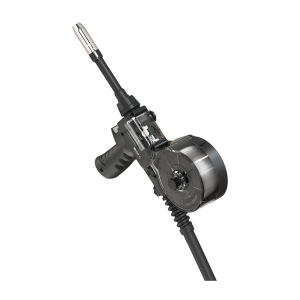
150 AMP Spool Gun
- Air-cooled
- Wire size 0.8mm-1.0mm
- CO2 duty cycle: 60% @ 150A
- Mixed Gas duty cycle: 60% @ 130A
View more info: 150 AMP Spool Gun
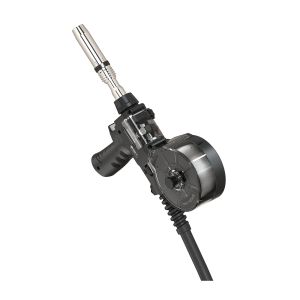
220 AMP Spool Gun
- Air-cooled
- Wire size 0.8mm-1.2mm
- CO2 duty cycle: 60% @ 220A
- Mixed Gas duty cycle: 60% @ 200A
View more info: 220 AMP Spool Gun
These two guns can both only carry a 1kg wire spool, so the one difference between the two is how many amps they output, and therefore how thick your filler wire can be. Because the spool gun feeds the wire directly through the torch, your drive rollers are located in the gun. You’ll need to make sure that the roller size matches your wire size.
Push-Pull Guns
Push-Pull guns are similar to spool guns in that they’re designed to make welding aluminium easier. A Push-Pull gun works by having a small, second motorised wire feeder directly in the gun. This motor works in harmony with the feeder inside the machine, and together they achieve a smooth feed as the machine pushes the wire through the torch lead and the gun pulls it through from the other end.
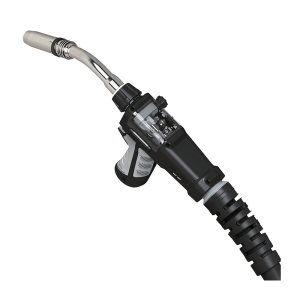
300 AMP Push-Pull Gun
- Air-cooled
- Wire size 0.8mm-1.2mm
- CO2 duty cycle: 60% @ 300A
- Mixed Gas duty cycle: 60% @ 270A
View more info: 300 AMP Push-Pull Gun
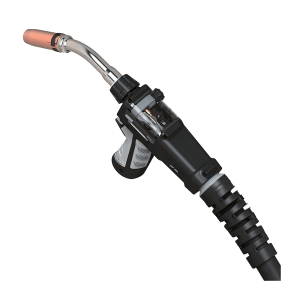
400 AMP Water-Cooled Push-Pull Gun
- Water-cooled
- Wire size 1.0mm-1.6mm
- CO2 duty cycle: 100% @ 400A
- Mixed Gas duty cycle: 100% @ 350A
View more info: 400 AMP Water-Cooled Push-Pull Gun
Because there’s an internal wire drive system in the gun, there are small rollers inside it. Like the spool gun, make sure you match the rollers to the wire size you’re using.
The Push-Pull guns have a Euro connection, too; however, they also come with a ‘pinout’ connection. Only a few machines have corresponding pinholes that will fit these pins, so Push-Pull guns are considered more ‘specialised’ than a spool gun.
The advantage of them, though, is that while they’re still a hefty gun, there isn’t an entire kilo resting on your hands. Plus, you can use standard sized spools so you can weld for longer.
The Push-Pull guns also have an 8-metre long lead (double the size of a standard MIG torch), giving you extra flexibility.
If you prefer the water-cooled version, you’ll need to purchase the water-cooling unit that the torch connects to separately.
Liners
A liner guides your wire inside the torch, and it ensures the wire makes it out of the torch tip. You may need to change your liner before you feed your wire through, as these liners – much like the rollers – will only fit specific sizes. There are separate liners for steel wires and aluminium wires.
Steel liners are fairly straight forward; they just need to match the wire size and can be inserted into the torch lead as they come.
If you’re going to use a standard MIG torch for an aluminium wire, you’ll need a teflon liner. These liners will need a neck spring attached to the top before they’re inserted. The neck spring keeps the liner ridged so it can be fed into the torch with no issues and keeps the wire from kinking.
Because there are several liner types and thicknesses, they’re colour-coded to make it easier for you.
| Blue | Red | Yellow | |
| Steel | 0.6-0.8mm | 0.9-1.2mm | 1.2-1.6mm |
| Aluminium | 0.6-0.8mm | 0.9-1.2mm | 1.2-1.6mm |
When purchasing the liners that you’ll need, make sure it’s the correct length for your torch, as they come in 3, 4 and 5 metres.
The wire sizes on the MIG torches are recommendations rather than strict guidelines, as you can insert most liners into the torch hoses. The problems arise if you put too thick a wire in a lower amperage machine. For example, if you were to try and weld 1.2mm thick filler wire with the Viper 182 Mk II, it wouldn’t melt properly, as its max amps (180) aren’t enough to heat it all the way through.
On the other hand, if you had a Razor 500 SWF, which comes with the SB38 torch, you could still use 0.6mm wire. The recommended is for 1.0mm-1.6mm; however, you can turn the amps on the machine low enough that you won’t just vaporise the wire as it feeds out of the torch. For all of these applications, make sure you have a liner size that matches your filler wire.